ECU Citroen C3 RHD 2014 2.G Owner's Manual
[x] Cancel search | Manufacturer: CITROEN, Model Year: 2014, Model line: C3 RHD, Model: Citroen C3 RHD 2014 2.GPages: 284, PDF Size: 8.99 MB
Page 52 of 284
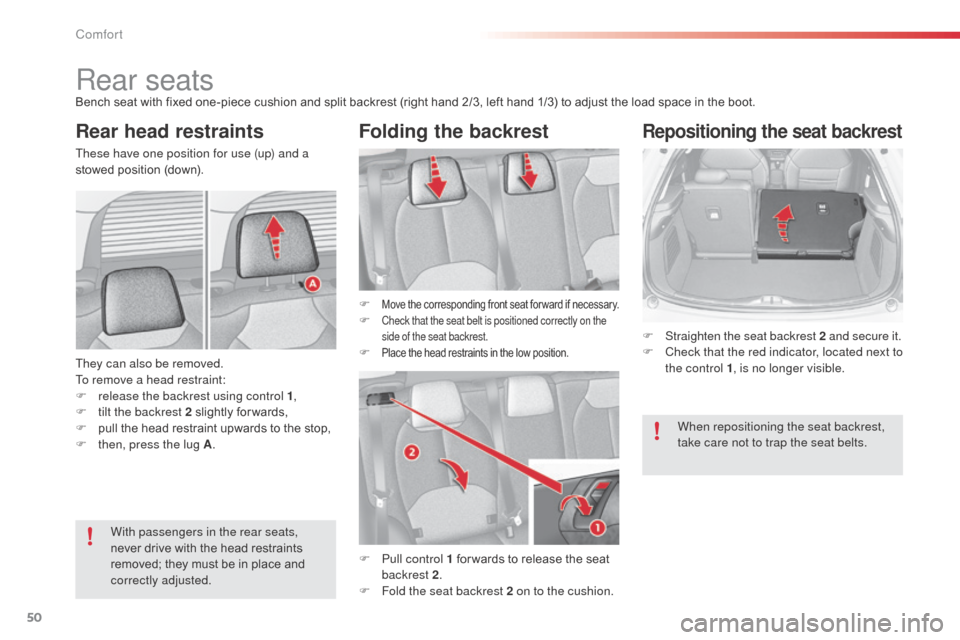
50
Rear seatsBench seat with fixed one-piece cushion and split backrest (right hand 2/3, left hand 1/3) to adjust the load space in the boot.
Rear head restraintsFolding the backrest
They can also be removed.
To remove a head restraint:
F
r
elease the backrest using control 1 ,
F
t
ilt the backrest 2 slightly for wards,
F
p
ull the head restraint upwards to the stop,
F
t
hen, press the lug A . F
Move the corresponding front seat for ward if necessary.F Check that the seat belt is positioned correctly on the
side of the seat backrest.
F Place the head restraints in the low position.
With passengers in the rear seats,
never drive with the head restraints
removed; they must be in place and
correctly adjusted.
These have one position for use (up) and a
stowed position (down).
F
P
ull control 1 for wards to release the seat
backrest 2 .
F
F
old the seat backrest 2 on to the cushion.
Repositioning the seat backrest
When repositioning the seat backrest,
take care not to trap the seat belts.
F
S
traighten the seat backrest 2
and secure it.
F
C
heck that the red indicator, located next to
the control 1 , is no longer visible.
Comfort
Page 66 of 284
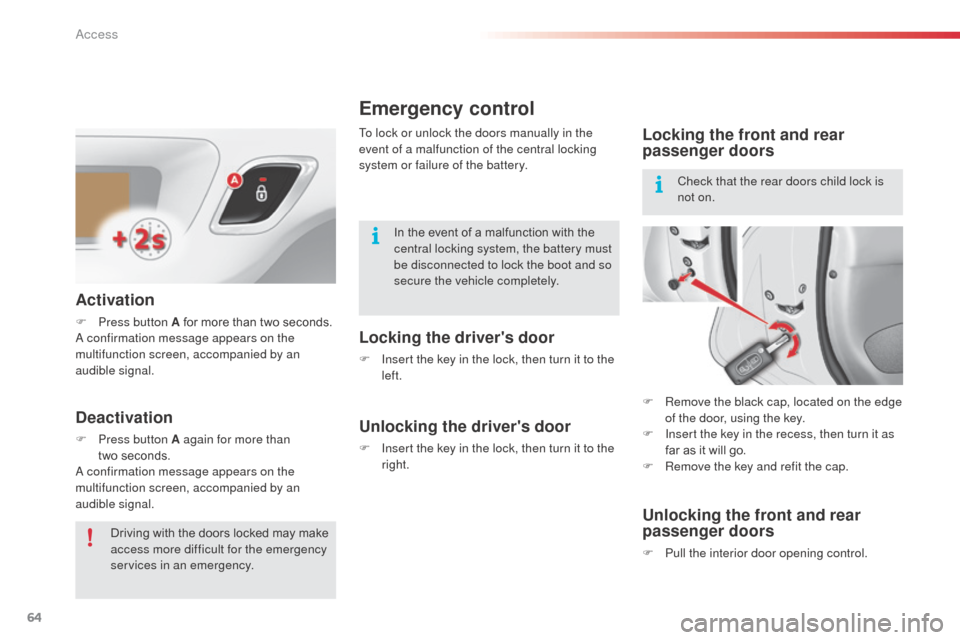
64
Emergency control
Locking the driver's door
F Insert the key in the lock, then turn it to the left.
Unlocking the driver's door
F Insert the key in the lock, then turn it to the right.
Locking the front and rear
passenger doors
F Remove the black cap, located on the edge of the door, using the key.
F
I
nsert the key in the recess, then turn it as
far as it will go.
F
R
emove the key and refit the cap.
Unlocking the front and rear
passenger doors
F Pull the interior door opening control.
In the event of a malfunction with the
central locking system, the battery must
be disconnected to lock the boot and so
secure the vehicle completely.
Check that the rear doors child lock is
not on.
To lock or unlock the doors manually in the
event of a malfunction of the central locking
system or failure of the battery.
Activation
F Press button A for more than two seconds.a
confirmation message appears on the
multifunction screen, accompanied by an
audible signal.
Deactivation
F Press button A again for more than two seconds.
a
confirmation message appears on the
multifunction screen, accompanied by an
audible signal.
Driving with the doors locked may make
access more difficult for the emergency
services in an emergency.
Access
Page 85 of 284
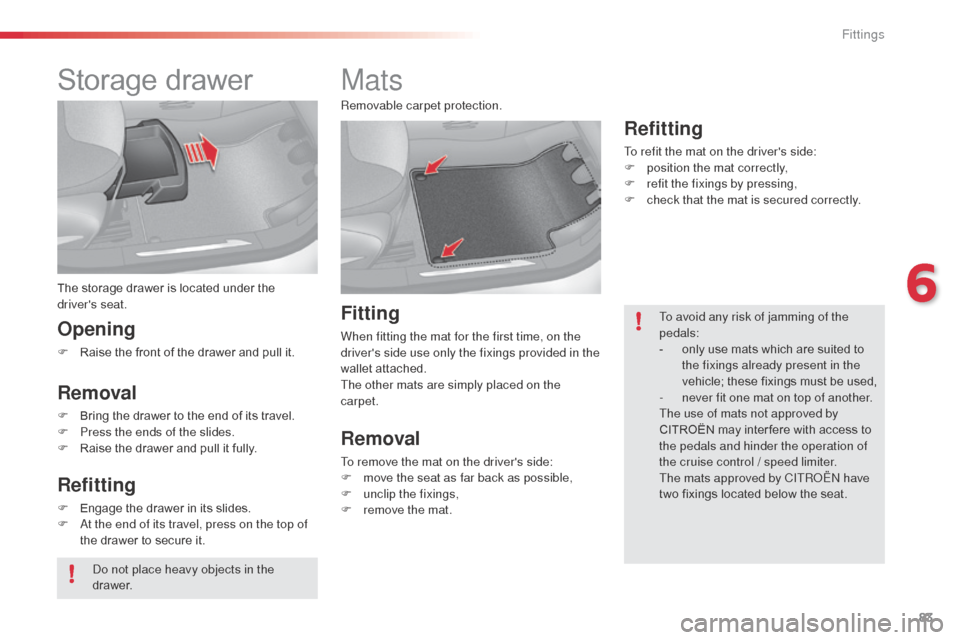
83
Storage drawer
The storage drawer is located under the
driver's seat.
Opening
F Raise the front of the drawer and pull it.
Removal
F Bring the drawer to the end of its travel.
F P ress the ends of the slides.
F
R
aise the drawer and pull it fully.
Refitting
F Engage the drawer in its slides.
F at t he end of its travel, press on the top of
the drawer to secure it.
Mats
Fitting
When fitting the mat for the first time, on the
driver's side use only the fixings provided in the
wallet attached.
The other mats are simply placed on the
carpet.
Removal
To remove the mat on the driver's side:
F m ove the seat as far back as possible,
F
un
clip the fixings,
F
r
emove the mat.
Refitting
To refit the mat on the driver's side:
F p osition the mat correctly,
F
r
efit the fixings by pressing,
F
c
heck that the mat is secured correctly.
To avoid any risk of jamming of the
pedals:
-
o
nly use mats which are suited to
the fixings already present in the
vehicle; these fixings must be used,
-
n
ever fit one mat on top of another.
The use of mats not approved by
CITROËN may inter fere with access to
the pedals and hinder the operation of
the cruise control / speed limiter.
The mats approved by CITR
oËn
have
two fixings located below the seat.
do n
ot place heavy objects in the
drawer. Removable carpet protection.
6
Fittings
Page 94 of 284
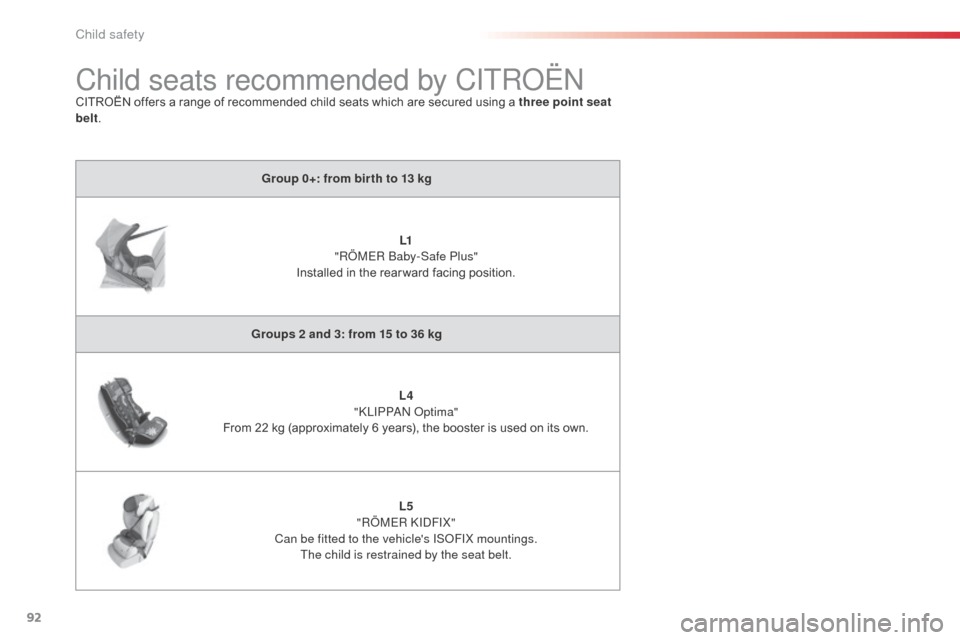
92
Child seats recommended by CITRoËnCITROËN offers a range of recommended child seats which are secured using a three point seat
belt.
Group 0+: from bir th to 13 kg
L1
"RÖMER
b
a
by-Safe Plus"
Installed in the rear ward facing position.
Groups 2 and 3: from 15 to 36 kg L4
"
kL
IPP
a
n o
p
tima"
From 22 kg (approximately 6 years), the booster is used on its own.
L5
"RÖMER
k I d FIX"
Can be fitted to the vehicle's IS
oF
IX mountings.
The child is restrained by the seat belt.
Child safety
Page 95 of 284

93
Weight of the child and indicative age
Seat Under 13 kg
(groups 0 (b) a n d 0 +)
Up to approx 1 year From 9 to 18 kg
(g r o u p 1)
1 to 3 years approx From 15 to 25 kg
(group 2)
3 to 6 years approx From 22 to 36 kg
(group 3)
6 to 10 years approx
Front passenger seat (c) UUUU
ou
ter rear seats UUUU
Centre rear seat UUUU
Installing child seats attached using the seat beltIn accordance with European regulations, this table indicates the options for installing child seats secured using a seat belt and universally approved (a)
in accordance with the weight of the child and the seat in the vehicle.
(a) Universal child seat: child seat that can be installed in all vehicles using a seat belt.
(b )
G
roup 0: from birth to 10 kg. Shells seats and baby carriers cannot be installed in the front
passenger seat. When installed in the 2
nd row, they may prevent use of the other seats.
(c ) Consult the legislation in force in your country before installing your child on this seat.
U :
S
eat suitable for the installation of a child seat secured using a seat belt and universally
approved, "rear ward facing" and/or "for ward facing". Remove and stow the head restraint
before installing a child seat with a
backrest on a passenger seat. Refit the
head restraint once the child seat has
been removed.
7
Child safety
Page 96 of 284
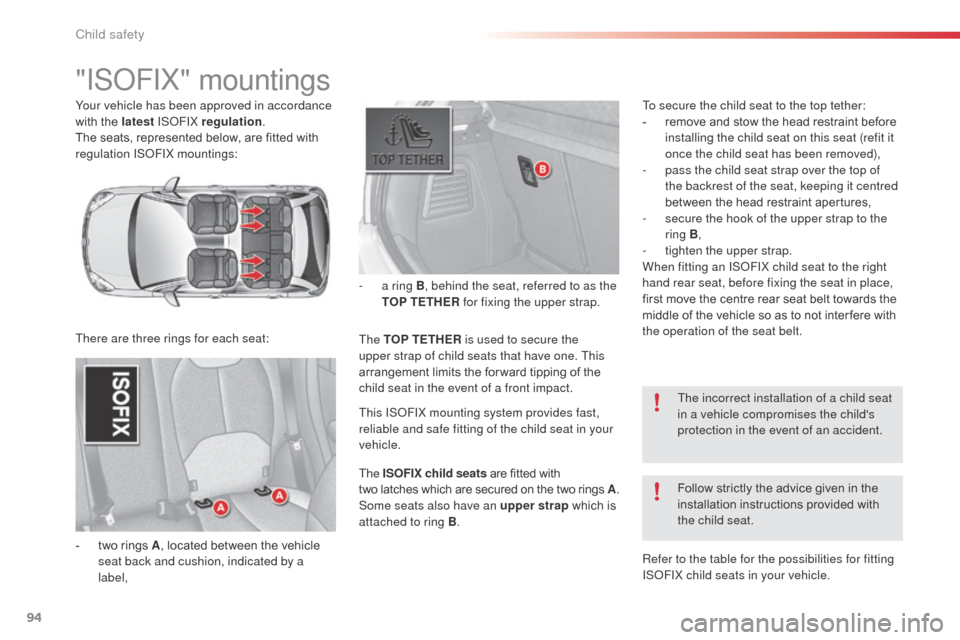
94
Your vehicle has been approved in accordance
with the latest ISoFIX regulation.
The seats, represented below, are fitted with
regulation IS
oF
IX mountings:
-
t
wo rings A , located between the vehicle
seat back and cushion, indicated by a
label, The TOP TETHER is used to secure the
upper strap of child seats that have one. This
arrangement limits the for ward tipping of the
child seat in the event of a front impact. -
a r
ing B, behind the seat, referred to as the
TOP TETHER for fixing the upper strap.
Follow strictly the advice given in the
installation instructions provided with
the child seat.
"ISoFIX" mountings
The incorrect installation of a child seat
in a vehicle compromises the child's
protection in the event of an accident.
There are three rings for each seat: To secure the child seat to the top tether:
-
r
emove and stow the head restraint before
installing the child seat on this seat (refit it
once the child seat has been removed),
-
p
ass the child seat strap over the top of
the backrest of the seat, keeping it centred
between the head restraint apertures,
-
s
ecure the hook of the upper strap to the
ring B ,
-
t
ighten the upper strap.
When fitting an IS
oF
IX child seat to the right
hand rear seat, before fixing the seat in place,
first move the centre rear seat belt towards the
middle of the vehicle so as to not inter fere with
the operation of the seat belt.
Refer to the table for the possibilities for fitting
IS
oF
IX child seats in your vehicle.
This ISoF
IX mounting system provides fast,
reliable and safe fitting of the child seat in your
vehicle.
The ISOFIX child seats are fitted with
two
l
atches which are secured on the two rings A.
Some seats also have an upper strap which is
attached to ring B .
Child safety
Page 97 of 284
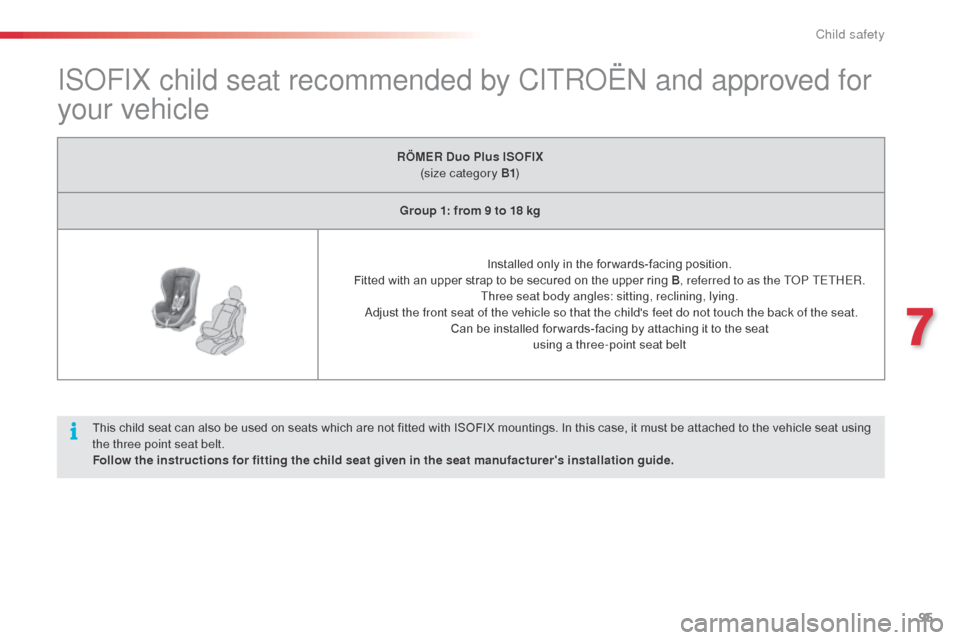
95
ISoFIX child seat recommended by CITRoËn and approved for
your vehicle
This child seat can also be used on seats which are not fitted with ISOFIX mountings. In this case, it must be attached to the vehicle seat using
the three point seat belt.
Follow the instructions for fitting the child seat given in the seat manufacturer's installation guide. RÖMER
Duo Plus ISOFIX
(size category B1 )
Group 1: from 9 to 18 kg
Installed only in the for wards-facing position.
Fitted with an upper strap to be secured on the upper ring B , referred to as the T
oP T
ETHER.
Three seat body angles: sitting, reclining, lying.
a
d
just the front seat of the vehicle so that the child's feet do not touch the back of the seat.
Can be installed for wards-facing by attaching it to the seat using a three-point seat belt
7
Child safety
Page 98 of 284

96
Installing ISoFIX child seatsIn accordance with European regulations, this table indicates the options for the installation of ISOFIX child seats on the vehicle seats fitted with
ISoF
IX mountings.
In the case of the universal and semi-universal ISOFIX child seats, the child seat's ISOFIX size category, determined by a letter between A and G , is
indicated on the child seat next to the IS
oF
IX logo.
I UF:
s
eat suitable for the installation of an I sofix Universal seat, " For ward facing" and secured
using the "T
oP T
ETHER" upper strap.
IL- SU: seat suitable for the installation an I sofix Semi-Universal seat which is:
-
"
rear ward facing" fitted with a "Top Tether" upper strap or a stay,
-
"
for ward facing" fitted with a stay,
-
b
aby cot fitted with a "Top Tether" upper strap or a stay.
For the securing of the "Top Tether" upper strap, refer to the "IS
oF
IX Mountings" section.
X:
s
eat which is not suitable for the installation of an ISOFIX child seat or cot of the weight group
indicated. Weight of the child and indicative age
Less than 10 kg (group 0)
Up to 6 months approx Less than 10 kg
(group 0)
Less than 13 kg (group 0+)
Up to 1 year approx From 9 to 18 kg (group 1)
From 1 to 3 years approx
Type of ISOFIX child seat Infant car seat"rear facing""rear facing""forward facing"
ISOFIX size categor y F G C D E C D A B B1
Universal and semi-universal ISOFIX child
seats which can be installed on the outer
rear seats X
XIL- SU XIL- SU IUF
IL- SU
Remove and stow the head restraint
before installing a child seat with a
backrest on a passenger seat. Refit the
head restraint once the child seat has
been removed.
Child safety
Page 99 of 284
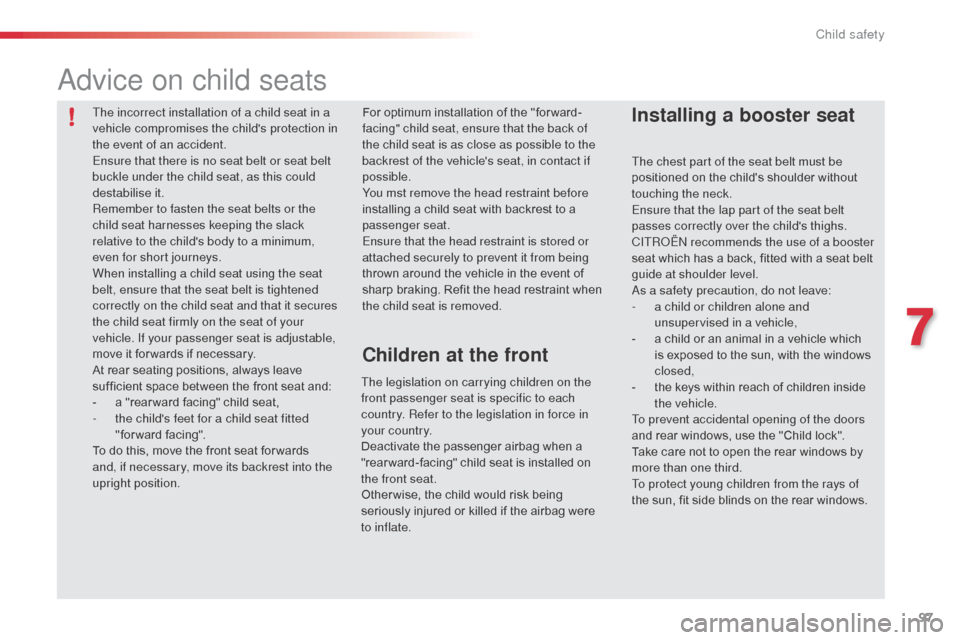
97
The chest part of the seat belt must be
positioned on the child's shoulder without
touching the neck.
Ensure that the lap part of the seat belt
passes correctly over the child's thighs.
CITR
oËn
recommends the use of a booster
seat which has a back, fitted with a seat belt
guide at shoulder level.
as a s
afety precaution, do not leave:
-
a c
hild or children alone and
unsupervised in a vehicle,
-
a c
hild or an animal in a vehicle which
is exposed to the sun, with the windows
closed,
-
t
he keys within reach of children inside
the vehicle.
To prevent accidental opening of the doors
and rear windows, use the "Child lock".
Take care not to open the rear windows by
more than one third.
To protect young children from the rays of
the sun, fit side blinds on the rear windows.
Children at the front Installing a booster seat
The legislation on carrying children on the
front passenger seat is specific to each
country. Refer to the legislation in force in
your country.
Deactivate the passenger airbag when a
"rear ward-facing" child seat is installed on
the front seat.
Other wise, the child would risk being
seriously injured or killed if the airbag were
to inflate.For optimum installation of the "for ward-
facing" child seat, ensure that the back of
the child seat is as close as possible to the
backrest of the vehicle's seat, in contact if
possible.
You mst remove the head restraint before
installing a child seat with backrest to a
passenger seat.
Ensure that the head restraint is stored or
attached securely to prevent it from being
thrown around the vehicle in the event of
sharp braking. Refit the head restraint when
the child seat is removed.
The incorrect installation of a child seat in a
vehicle compromises the child's protection in
the event of an accident.
Ensure that there is no seat belt or seat belt
buckle under the child seat, as this could
destabilise it.
Remember to fasten the seat belts or the
child seat harnesses keeping the slack
relative to the child's body to a minimum,
even for short journeys.
When installing a child seat using the seat
belt, ensure that the seat belt is tightened
correctly on the child seat and that it secures
the child seat firmly on the seat of your
vehicle. If your passenger seat is adjustable,
move it for wards if necessary.
At rear seating positions, always leave
sufficient space between the front seat and:
-
a "
rear ward facing" child seat,
-
t
he child's feet for a child seat fitted
"forward facing".
To do this, move the front seat for wards
and, if necessary, move its backrest into the
upright position.
advice on child seats
7
Child safety
Page 110 of 284
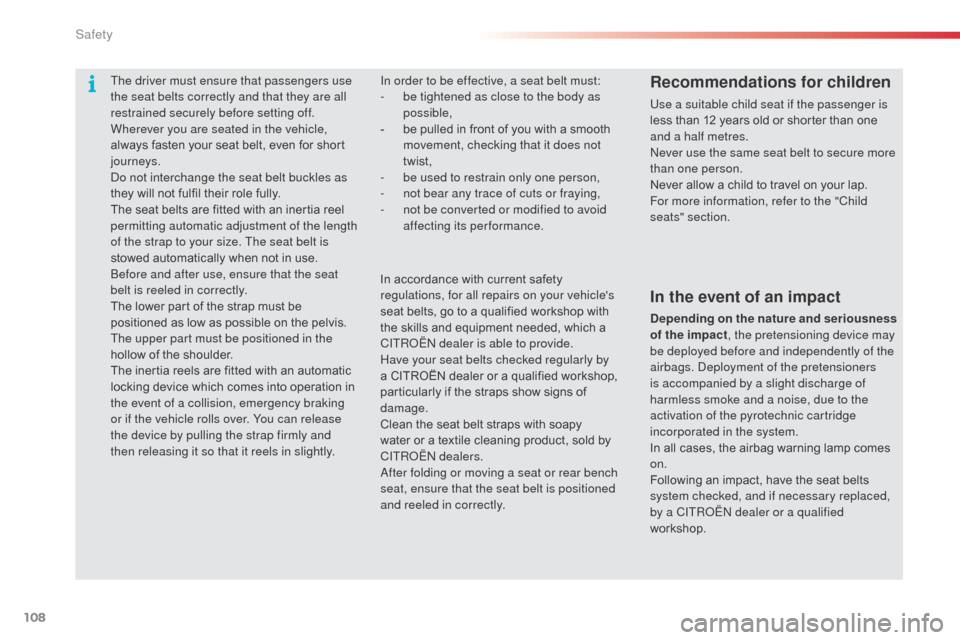
108
The driver must ensure that passengers use
the seat belts correctly and that they are all
restrained securely before setting off.
Wherever you are seated in the vehicle,
always fasten your seat belt, even for short
journeys.
do n
ot interchange the seat belt buckles as
they will not fulfil their role fully.
The seat belts are fitted with an inertia reel
permitting automatic adjustment of the length
of the strap to your size. The seat belt is
stowed automatically when not in use.
be
fore and after use, ensure that the seat
belt is reeled in correctly.
The lower part of the strap must be
positioned as low as possible on the pelvis.
The upper part must be positioned in the
hollow of the shoulder.
The inertia reels are fitted with an automatic
locking device which comes into operation in
the event of a collision, emergency braking
or if the vehicle rolls over. You can release
the device by pulling the strap firmly and
then releasing it so that it reels in slightly.Recommendations for children
Use a suitable child seat if the passenger is
less than 12 years old or shorter than one
and a half metres.
ne
ver use the same seat belt to secure more
than one person.
Never allow a child to travel on your lap.
For more information, refer to the "Child
seats" section.
In order to be effective, a seat belt must:
-
b
e tightened as close to the body as
possible,
-
b
e pulled in front of you with a smooth
movement, checking that it does not
twist,
-
b
e used to restrain only one person,
-
n
ot bear any trace of cuts or fraying,
-
n
ot be converted or modified to avoid
affecting its performance.
In accordance with current safety
regulations, for all repairs on your vehicle's
seat belts, go to a qualified workshop with
the skills and equipment needed, which a
CITR
oËn
dealer is able to provide.
Have your seat belts checked regularly by
a CITROËN dealer or a qualified workshop,
particularly if the straps show signs of
damage.
Clean the seat belt straps with soapy
water or a textile cleaning product, sold by
CITR
oËn d
ealers.
af
ter folding or moving a seat or rear bench
seat, ensure that the seat belt is positioned
and reeled in correctly.
In the event of an impact
Depending on the nature and seriousness
of the impact , the pretensioning device may
be deployed before and independently of the
airbags.
d
ep
loyment of the pretensioners
is accompanied by a slight discharge of
harmless smoke and a noise, due to the
activation of the pyrotechnic cartridge
incorporated in the system.
In all cases, the airbag warning lamp comes
on.
Following an impact, have the seat belts
system checked, and if necessary replaced,
by a CITR
oËn
dealer or a qualified
workshop.
Safety